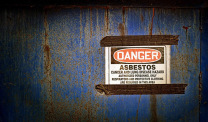U.S. Asbestos Imports Increased Significantly in 2020
Asbestos Exposure & BansWritten by Tim Povtak | Edited By Walter Pacheco

An estimated 300 metric tons of raw chrysotile asbestos was imported into the U.S. in 2020, almost doubling the amount from 2019, according to the recent United States Geological Survey Mineral Commodity Summaries report.
The chloralkali industry accounted for 100% of the imports, all from Brazil. This industry uses the asbestos in the manufacturing of semipermeable diaphragms for making chlorine.
Asbestos import numbers were the second smallest in more than 50 years and only a fraction of the all-time high of 803,000 tons reported in 1973.
Also imported into the United States, but not included in the report, is a small but unknown amount of asbestos within manufactured products. This includes vehicle friction products, rubber sheets for gaskets used to make titanium dioxide, and brake blocks used in the oil industry.
Exposure to asbestos can lead to serious illnesses, including mesothelioma, a rare cancer with no definitive cure.
Although asbestos already is heavily regulated within the U.S. today, there is growing sentiment to further tighten restrictions and move closer to a total ban of the mineral.
EPA Moving Toward Tighter Control of Asbestos
The U.S. Environmental Protection Agency released Part 1 of its Final Risk Evaluation for chrysotile asbestos in 2020, finding “unreasonable risks to human health” with the manufactured products still entering the country and within the chloralkali industry.
Part 2 of the EPA’s Final Risk Evaluation is expected by mid-2021 and will include the broad issue of legacy asbestos, which poses the greatest danger today to human health.
The long-standing but recently amended Toxic Substances Control Act will require the EPA to propose and finalize actions that address all risks by the end of 2022.
Legislative efforts are still being pushed in Congress to ban asbestos, although they have failed consistently for more than a decade. The latest effort was H.R. 1603, the Alan Reinstein Ban Asbestos Now Act of 2020, which had bipartisan support less than a year ago. Political infighting among its supporters led to its demise.
Unbridled Use of Asbestos in 1970s
Asbestos, a naturally occurring mineral that could strengthen most anything with which it was mixed, was once a highly coveted ingredient because of its heat resistance and versatility.
Products made with asbestos were a staple in commercial and residential construction, posing the biggest risk today from its earlier unbridled use. As asbestos products age and are disturbed, they send toxic fibers into the air, posing considerable danger if inhaled or ingested.
This danger led to the closing, or partial closing, of almost a dozen older Philadelphia schools in 2019. All were built before 1978 and were in various stages of renovation.
U.S. Importation of Raw Asbestos
Consumption of asbestos has fallen dramatically through the years following its peak in the 1970s, when imports ranged from 551,000 tons in 1979 to a high of 803,000 tons in 1973.
Mining of asbestos within the U.S. ended in 2002.
| Year | Metric Tons |
|---|---|
| 2010 | 1,040 |
| 2011 | 1,180 |
| 2012 | 1,610 |
| 2013 | 772 |
| 2014 | 406 |
| 2015 | 325 |
| 2016 | 747 |
| 2017 | 332 |
| 2018 | 681 |
| 2019 | 172 |
| 2020 | 300 |
The 300-ton figure for 2020 could change significantly in the coming weeks based upon updated information. A rate of 172 tons in 2019, for example, was originally reported as 100 tons. In 2018, the amount reported was originally 750 tons, but later dropped to 681 tons.
This recent Geological Survey Mineral Commodity Summaries report estimated the consumption of 450 tons for 2020 in the U.S., based upon a five-year rolling average of imports, allowing for possible use of stockpiled asbestos from previous years.
Chloralkali Industry Still Powerful Asbestos Advocate
The chloralkali industry has been the only domestic consumer of raw asbestos since 2016. According to the report there are 11 chloralkali plants in the U.S. still using asbestos. They are making one-third of the chlorine being produced in the country.
This industry has been the most outspoken critic of legislation that includes an outright ban, but has supported tighter regulations that exclude its own use. Most other industries have found alternative materials and stopped the use of asbestos.
Estimated worldwide usage of asbestos, according to the report, has dropped from 2 million tons in 2010 to 1.2 million tons in recent years. Russia remains the biggest producer at 790,000 tons annually.






